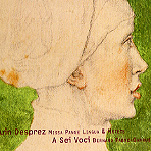Josquin Desprez, who bridged the 15th and 16th centuries, stands at the musical pinnacle of his era much the same as Bach did two centuries later. And also like Bach, Josquin’s music exudes a timelessness and power that transcends simple classification or comparison. And every time you listen or perform their works, you’re likely to hear something new or discover something different. Josquin’s Mass based on the plainchant “Pange lingua” (for the feast of Corpus Christi) apparently was his last in the genre, and it’s a marvel of compositional economy and structural symmetry. It’s not that it’s particularly short–it’s more than 30 minutes long–nor does it have some mathematically precise dimensions; it’s just that everything seems perfectly made and in its place. Some of the work’s more moving sections are written in a striking homophonic style, showing what a master can do with a few well-chosen chords!
The mass is performed by the male-voice A Sei Voci joined with Maîtrise des Pays de Loire, an excellent (mostly female) French choir school ensemble. The plainchant singing is lovely, the all-important phrasing right on, and the incredible shimmering resonance of the 12th-century Church of Saint-Robert (a site already 300 years old at the time of Josquin’s birth) adds a dynamic force that mostly enhances the music’s ancient, mystical aura. The effect is especially remarkable in the Gradual chant, “Christus factus est”, where the final notes of phrases still haunt the air as the next phrase begins. But Saint-Robert’s legendary acoustics also turn against the performers when the volume rises above a certain level and when the full mixed ensemble sings together (as shortly after the beginning of the Kyrie). The sound tends to blend together too much, saturating the harmonies and drenching the individual lines. It still carries its own kind of beauty, but our ears nevertheless sense a missing clarity in these passages. None of these acoustic problems affect the three exquisite motets, sung alone by the nine voices of A Sei Voci. They don’t have the silky, finely polished smoothness of the Hilliard Ensemble, for instance; rather, theirs is an edgier timbre that carries and penetrates more like the gut strings or double reeds of Josquin’s time. And like Josquin’s music it resounds in the room and in the ear long after its initial utterance.
































